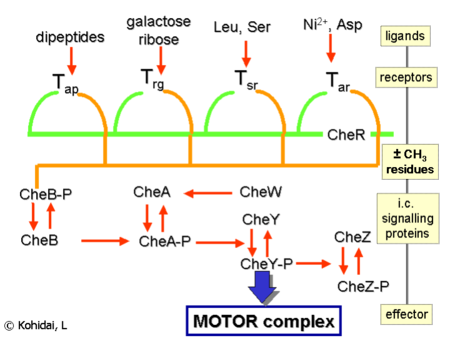
Multiscale Modeling of Bacterial Chemotaxis with Interactive User Interface
Introduction of Chemotaxis
It has been discovered that bacteria swim towards more highly concentrated areas of attractant chemicals and avoid environments with higher repellent concentrations. This behavior is called chemotaxis. Becteria achieve this by sensing chemical concentrations outside the cell with their receptors, then inducing a series of chemical reactions in the cell, and finally deciding where to go, by changing their swimming patterns.
A complicated chemical network describes how signals such as outside the cell are transducted through the pathway and affect the moving patterns of the cell.

Motivation
Chemotaxis has been a well studied chemical phenomenon for bacteria, especially for E-coli. To study the mechanism that controls this interesting behavior, many models have been built, particulary the pioneering modeling work by Howard Berg's group and D. Bray's group. Noteblely in 2005, using StochSim [1], an agent-based simulator AgentCell [2] was introduced that includes alternate moving patterns (switching between swimming and tumbling) of the bacterium, and a graphic display of the bacteria moving in an environment with a simple distribution of attractant chemicals.
According to observations in experiments, E-coli can respond to very tiny change of concentration of attractant. This high sensitivity has far exceeded the sensitivity of existing computer models. Recently, Dr. Bray's group proposed a new model [3] that shows better match with the experimental data. they assume that the binding of one receptor by attractant chemical can induce its neighbor receptors to act as if they were bound by the same chemical as well, thus amplifying the sensitivity of the model. This mechanism was called the infectivity. Using their existing BCT program and introducing the new concept infectivity into the model, they have achievd the high sensitvity of the bacterium cell, and increasing the adaptation rate.
However, the modeling progress so far deals with only simple environments. It is challenging to model the bacteria behavior in more complicated and realistic scenarios. This project focuses on the multiscale modeling and simulation of the bacteria behavior in a dynamically varying environments. Through a human-computer interaction interface, changes for the chemicals in the environment can be achieved through human interaction and natural chemical diffusion. Chemotaxis control mechanisms are implemented and compared under this condition.
References
1. Carl J. Morton-Firth & Dennis Bray (1998), Predicting Temporal Fluctuations in an Intracelllar Signalling Pathway, J. theor. Biol. 192, 117-128.
2. Thierry Emonet et al. (2005), AgentCell: a digital single-cell assay for bacterial chemotaxis, Systems biology 21, 2714-2721.
3. Dennis Bray et al. (2007), The Chemotactic Behavior of Computer-Based Surrogate Bacteria, Current Biology 17, 12-19.